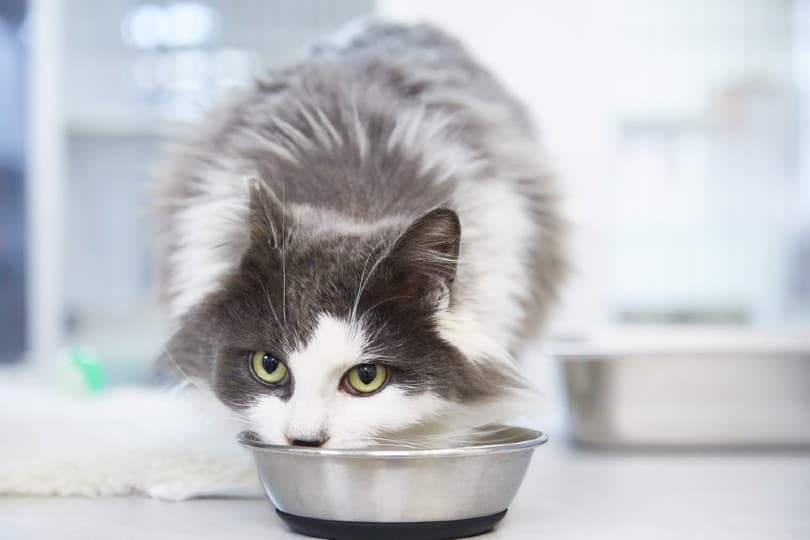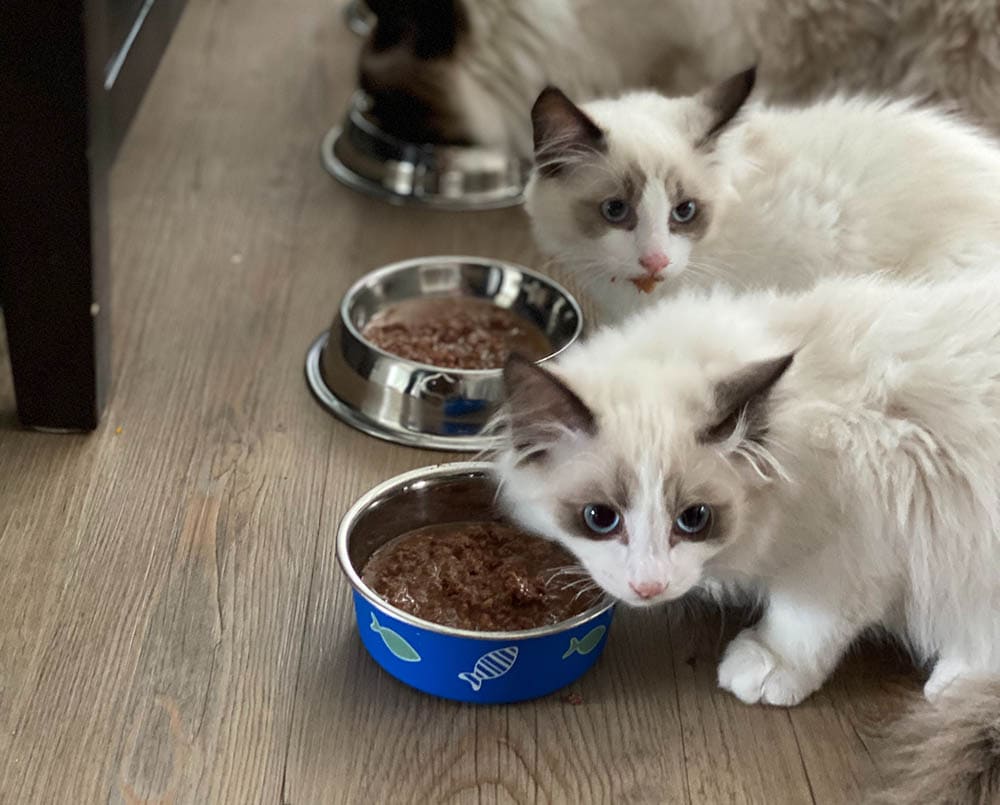It can be tough to know what the best cat food is for your pet. After all, there are so many brands and varieties on the market these days. But don’t worry—we’re here to help!
In this post, we’ll look at the best cat foods in Australia right now, each backed with glowing reviews. So, if you’re looking for some recommendations, you’ve come to the right place!
A Quick Look at Our Favorites in 2024
| Image | Product | Details | ||
|---|---|---|---|---|
| Best Overall |

|
Purina Cat Chow Natural Cat Food |
|
Check Price |
| Best Value |

|
IAMS Proactive Health Cat Food |
|
Check Price |
| Premium Choice |

|
Royal Canin Feline Health Cat Food |
|
Check Price |
| Best for Kittens |

|
Purina Pro Plan Chicken Formula |
|
Check Price |

|
Purina Fancy Feast Wet Cat Food |
|
Check Price |
The 10 Best Cat Foods in Australia
1. Purina Cat Chow Natural Cat Food – Best Overall
| Protein: | 34% |
| Fat: | 9% |
| Calories: | 371 kcal/cup |
| Main ingredients: | Chicken, corn, rice |
One of the biggest selling points of this cat food is that it is made with natural ingredients. The first ingredient is real chicken, and there are no artificial flavors or preservatives. This is good news for cats that are picky eaters or that have sensitive stomachs. In addition, Purina Cat Chow Natural contains no fillers or wheat gluten, which can sometimes be hard for cats to digest.
On the downside, some cat owners have found that their cats don’t seem to like the taste of Purina Cat Chow Natural as much as other brands. And because it is made with natural ingredients, it can be more expensive than some other options on the market. Overall, though, Purina Cat Chow Natural is a quality food that can provide your cat with the nutrition they need, which is why we chose it as the best overall cat food in Australia.
2. IAMS Proactive Health Cat Food – Best Value
| Protein: | 32% |
| Fat: | 15% |
| Calories: | 399 kcal/cup |
| Main ingredients: | Chicken (whole, by-product, and meal), corn, beet pulp |
IAMS Proactive Health was our pick for the best cat food for the money in Australia. This is a popular brand of cat food that promises to provide all the nutrients your cat needs for a healthy life. The food is made with real chicken and other natural ingredients, and it contains no artificial flavors or colors. IAMS Proactive Health cat food also includes omega-3 fatty acids for healthy skin and coat, as well as antioxidants to support a strong immune system.
There are several things to like about IAMS Proactive Health cat food. First, the use of real chicken as the primary ingredient is a big plus. Second, the inclusion of omega-3 fatty acids and antioxidants is also beneficial for your cat’s health. Finally, the fact that there are no artificial flavors or colors is another plus.
However, there are a few things to keep in mind before deciding if IAMS Proactive Health is the right choice for your cat. Some cats may find the other ingredients, such as corn, gluten, and wheat, to be irritating to the stomach and hard to digest. Overall, IAMS Proactive Health is a good choice for many cats, but it’s important to do your research before selecting a food for your feline friend.
3. Royal Canin Feline Health Cat Food – Premium Choice
| Protein: | 27% |
| Fat: | 15% |
| Calories: | 325 kcal/cup |
| Main ingredients: | Chicken, corn, rice |
Royal Canin Feline Health Nutrition Indoor cat food is a popular choice for indoor cats, and it’s easy to see why. The kibble is small and easy to chew, and it’s packed with all the nutrients an indoor cat needs. It is also specially formulated to reduce hairballs and help control weight. One of the main ingredients in this food is chicken meal, which is an excellent source of protein.
As our premium choice, the price is on the higher end. There are some other drawbacks to this food as well. First, it contains a lot of fillers (such as grains and soy), which can cause digestive problems in some cats. Additionally, the kibble is very hard, making it difficult for older cats or those with dental problems to eat. Overall, Royal Canin Feline Health Nutrition Indoor cat food is a decent choice for indoor cats, but it’s not perfect.
4. Purina Pro Plan Dry Cat Food – Best for Kittens
| Protein: | 41% |
| Fat: | 21% |
| Calories: | 543 kcal/cup |
| Main ingredients: | Chicken, rice, salmon |
For kitten owners looking for a high-quality food option, Purina Pro Plan Chicken Formula is a great choice. This food is made with real chicken as the first ingredient, and it also includes DHA for brain and eye development.
In addition, the formula is designed to be highly digestible, so kittens can get the most out of their food. One downside of this food is that it is more expensive than some other brands on the market. However, many owners feel that the quality of the ingredients justifies the cost.
Overall, Purina Pro Plan Chicken Formula is a nutritious option that can help kittens grow and develop into healthy cats.
5. Purina Fancy Feast Wet Cat Food
| Protein: | 11% |
| Fat: | 2% |
| Calories: | 85 kcal/can |
| Main ingredients: | Seafood (cod, salmon, tuna, whitefish), fish broth, water |
Fancy Feast cat food is a popular wet food that is available in a variety of flavors. The main ingredients in most formulas are chicken, fish, or liver, and the food is typically served in small cans or pouches.
One of the main attractions of Fancy Feast Gravy cat food is the fact that it is relatively affordable compared to other wet foods on the market. Another plus is that the food contains no artificial colors or flavorings.
The gravy is also a great source of hydration, which is important for cats that don’t drink enough water on their own. Some reviewers have noted that their cats refuse to eat dry food after trying Purina Fancy Feast Gravy, so be prepared to make the switch if you decide to give this product a try.
6. Purina Fancy Feast Dry Cat Food
| Protein: | 34% |
| Fat: | 17% |
| Calories: | 471 kcal/cup |
| Main ingredients: | Rice, chicken by-products, beef |
If you’re looking for nutritious and delicious dry food for your feline friend, you may want to consider Purina Fancy Feast. This popular brand offers a variety of flavors and formulas to suit every cat’s taste.
However, there are also some potential downsides to Purina Fancy Feast. For example, some formulas are high in calories, which can contribute to weight gain in cats. In addition, Purina Fancy Feast is one of the more expensive brands on the market. Overall, Purina Fancy Feast is a good option for those who want to give their cat a healthy and flavorful diet. Just be sure to choose the right formula for your pet’s needs.
7. Nutro Wholesome Essentials Cat Food
| Protein: | 33% |
| Fat: | 16% |
| Calories: | 414 kcal/cup |
| Main ingredients: | Salmon, chicken meal, rice |
Nutro Wholesome Essentials is a brand of cat food that promises to be devoid of fillers, preservatives, and artificial flavors. Instead, it claims to use only natural ingredients that will provide your cat with the nutrients it needs.
While this sounds ideal, there are some drawbacks to Nutro Wholesome Essentials. First, it is one of the more expensive brands on the market. In addition, some reviewers have noted that their cats didn’t seem to enjoy the taste of the food. Overall, Nutro Wholesome Essentials is a decent option for those who want to give their cat a natural diet, but it may not be the best choice for everyone.
8. Blue Buffalo Indoor Health Natural Adult Dry Cat Food
| Protein: | 32% |
| Fat: | 15% |
| Calories: | 415 kcal/cup |
| Main ingredients: | Salmon, chicken meal, rice, oatmeal |
This premium food from Blue Buffalo is made with real meat and fish, as well as fresh fruits and vegetables. It also contains no artificial colors, flavors, or preservatives. Plus, the added vitamins and minerals help to keep your cat healthy and active. The only downside is that it’s slightly more expensive than some other brands on the market. However, you definitely get what you pay for with this high-quality food.
One of the biggest selling points of this food is that it contains no artificial ingredients, flavors, or preservatives. This is important for many cat owners who want to avoid giving their pets anything that could potentially be harmful. In addition, the formula is high in protein and low in carbohydrates, which is ideal for cats that are prone to weight gain. It also includes omega-3 fatty acids, which can help improve skin and coat health.
On the downside, some reviewers have complained that this food doesn’t seem to agree with all cats. Some have reported digestive issues after switching to this diet, so it’s important to monitor your pet closely if you decide to make the switch.
9. Dine Saucy Morsels Cat Food
| Protein: | 8% |
| Fat: | 5% |
| Calories: | 80 kcal/portion |
| Main ingredients: | Meat, fish, binder |
Dine Saucy Morsels is a limited ingredient, pre-portioned, and higher moisture content cat food. The recipe is limited-ingredient, meaning it’s great for cats with grain sensitivities. We also liked that it was pre-portioned for ease of use, however, that does mean a larger degree of waste from packaging.
The recipe also had a high moisture content for hydration, but this makes the food watery and messy to serve. Overall, the pros outweigh the cons, and we would recommend this food to pet owners.
10. Ziwi Peak Canned Lamb Recipe
| Protein: | 9.5% |
| Fat: | 6% |
| Calories: | 113 kcal per 3-oz can |
| Main ingredients: | Lamb (whole and organs), green-lipped mussels |
Ziwi Peak’s canned Lamb Recipe is a recipe made from 95% grass-fed lamb, organs, and bone, with a small amount of New Zealand green-lipped mussel for added nutrients.
The first thing you’ll notice about this food is the extremely short list of ingredients – just lamb, lamb organs, and bone, with a few green-lipped mussel for added nutrients. The company prides itself on using only ethically and sustainably sourced ingredients from New Zealand, which is reflected in the quality of the food.
One thing to keep in mind with this food is that it is quite high in calories, so it’s not suitable for cats that are overweight or obese. It’s also important to note that this food does not contain any grains, fillers, or artificial additives.
Overall, Ziwi Peak’s Lamb Recipe is a high-quality, grain-free food that is perfect for cat owners who are looking for an alternative to the typical dry kibble diet. However, because of the high-calorie content, it’s important to feed this food in moderation.
 Buyer’s Guide: How to Select the Best Cat Food in Australia
Buyer’s Guide: How to Select the Best Cat Food in Australia
Nutritional Breakdown of Cat Food
Protein
Cats are obligate carnivores, which means that they require animal-based protein in their diet to survive. Protein is essential for muscle growth and repair, and it also helps to keep the immune system strong. The minimum amount of protein that a cat food should contain is 26 grams/100 grams dry matter for adult cats.
Fat
Fat is an important source of energy for cats, and it also helps to keep the coat healthy and shiny. Fat is also essential for the absorption of certain nutrients, such as vitamins A, D, E, and K. Fat sources in cat food include chicken fat, fish oil, and flaxseed oil. The minimum amount of fat that a cat food should contain is 3 grams/100 kcal for adult cats.
Carbohydrates
Carbohydrates are not an essential part of the diet for cats, but they can be a source of energy and fiber. Carbohydrate sources in cat food include rice, wheat, and corn. The maximum amount of carbohydrates that a cat food should contain is 5 grams/100 kcal for adult cats.
Fiber
Dietary fiber is important for digestive health, and it can also help to regulate blood sugar levels. Fiber sources in cat food include pumpkin, psyllium husk, and flaxseed. The minimum amount of fiber that a cat food should contain is 0.5% for adult cats.

Vitamins and Minerals
Cats need a variety of vitamins and minerals in their diet to stay healthy, including vitamins A, B, C, D, and E, as well as minerals such as phosphorus, potassium, and magnesium. These nutrients can be found in animal-based ingredients such as meat, organs, and fish, as well as in plant-based ingredients such as fruits and vegetables.
Taurine is an essential amino acid that is found naturally in animal-based proteins. It is important for heart health, eye health, and reproduction. Taurine can also be found in some synthetic vitamin supplements. The minimum amount of taurine that a cat food should contain is 0.1% for dry foods and 0.2% for wet foods.
Water
Water is an essential nutrient for all cats, and it should be available at all times. The minimum amount of water that a cat food should contain is 78% for wet foods and 10% for dry foods.
Cat Food Standards in Australia
The Australian government has set standards for the manufacture and labeling of cat food. These standards are regulated by the Australian Competition and Consumer Commission (ACCC).
The Australian Standard for the Manufacturing and Marketing of Pet Food (AS5812-2017) sets out requirements for the manufacturing, packaging, storage, and labeling of pet food. The standard covers all types of pet food, including cat food.
The standard requires that all cat food products must be safe for consumption and that they must meet the nutritional needs of cats. The food must also be produced under hygienic conditions, and it must be labeled accurately and correctly.
All cat food products sold in Australia must comply with the requirements of the standard.
The ACCC is responsible for enforcing the standard, and it can take action against companies that do not comply with the requirements.

How Much to Feed Your Cat
The amount of food that you should feed your cat will depend on its age, weight, and activity level.
Kittens (up to 12 months old)
Kittens need a lot of energy to grow and develop, so they require more calories than adult cats. Kittens should be fed four times a day.
A kitten needs about 20 calories per pound of body weight per day.
Adult Cats (1–6 years old)
Adult cats should be fed two to three times a day. An adult cat needs about 15 calories per pound of body weight per day.
Senior Cats (7 years and older)
As cats age, they tend to become less active and have a slower metabolism, so they need fewer calories. Senior cats should be fed two times a day. A senior cat needs about 10 calories per pound of body weight per day.
Overweight Cats
If your cat is overweight, you should feed fewer calories to help them lose weight. You should also talk to your veterinarian about an appropriate weight-loss plan.
Underweight Cats
If your cat is underweight, you should feed more calories to help them gain weight. You should also talk to your veterinarian about an appropriate weight-gain plan.

Choosing the Best Cat Food for Your Cat
When choosing cat food, it is important to consider your cat’s individual needs. Age, activity level, and health condition will all affect the type of food that is best for your cat.
Life Stage
The first thing to consider when choosing cat food is your cat’s life stage. Kittens, adult cats, and senior cats all have different nutritional needs.
Kittens need more calories and protein than adult cats to support their rapid growth and development. They also need high levels of certain nutrients, such as taurine, to support their health.
Adult cats need fewer calories than kittens, but they still need high-quality protein to maintain their health. They also need certain nutrients, such as taurine, to support their health.
Senior cats generally need fewer calories than adult cats. They also may need higher levels of certain nutrients, such as omega-3 fatty acids, to support their health.
Activity Level
The next thing to consider is your cat’s activity level. Active cats burn more calories than inactive cats and need more calories in their diet. Inactive cats may need fewer calories to prevent them from becoming overweight.
Health Conditions
Certain health conditions can also affect the best type of food for your cat. Cats with diabetes, for example, may need food that is high in fiber and low in sugar. Cats with kidney disease may need food that is low in protein. Talk to your veterinarian about your cat’s specific dietary needs.
Allergies and Intolerances
Some cats have allergies or intolerances to certain ingredients. If your cat has an allergy or intolerance, you will need to avoid foods that contain the offending ingredient.
Conclusion
Our best overall pick for cat food in Australia was Purina Cat Chow Natural. This food is made with high-quality ingredients and provides cats with all the nutrients they need to stay healthy.
IAMS Proactive Health was our best value pick. This food is a good option for budget-conscious cat owners who still want to feed their cats a high-quality diet.
All the choices come complete with hordes of happy pet owners with positive reviews, so you really can’t go wrong with any of these foods!
Featured Image Credit: Sweetlouise, Pixabay















 Buyer’s Guide: How to Select the Best Cat Food in Australia
Buyer’s Guide: How to Select the Best Cat Food in Australia



